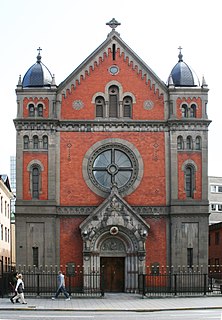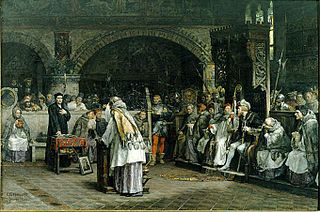
The Church of Sweden is an Evangelical Lutheran national church in Sweden. A former state church, headquartered in Uppsala, with around 5.6 million members at year end 2021, it is the largest Christian denomination in Sweden, the largest Lutheran denomination in Europe and the third-largest in the world, after the Ethiopian Evangelical Church Mekane Yesus and the Evangelical Lutheran Church in Tanzania.

The Catholic Church in Sweden was established by Archbishop Ansgar in Birka in 829, and further developed by the Christianization of Sweden in the 9th century. King Olof Skötkonung is considered the first Christian king of Sweden.

The Archbishop of Uppsala has been the primate of Sweden in an unbroken succession since 1164, first during the Catholic era, and from the 1530s and onward under the Lutheran church.

Samuel Troilius was Archbishop of Uppsala from 1758 to his death.

Uno von Troil was the Church of Sweden Archbishop of Uppsala 1786–1803.

Magnus Olai Beronius was Archbishop of Uppsala in the Church of Sweden from 1764 to his death.

Olaus (Olov) Svebilius was a Swedish priest and professor. He was Bishop of the Diocese of Linköping and Archbishop of Uppsala. His most notable work was Martin Luthers Lilla katekes med Katekesförklaring, a Swedish language translation and explanation of Luther's Small Catechism.
Bishops of the Diocese of Linköping, Sweden.

The Diocese of Stockholm is an exempt Latin Catholic ecclesiastical bishopric in Sweden and the only Roman Catholic diocese established in Sweden since the Protestant Reformation.

Johannes Matthiae Gothus was a Swedish Lutheran Bishop of Strängnäs and a professor of Uppsala University, the rector of the Collegium illustrious in Stockholm (1626–1629) and the most eminent teacher in Sweden during the seventeenth century. He was Bishop of Strängnäs from 1643 to 1664.

Johannes Gezelius the elder, known in Swedish as Johannes Gezelius den äldre and Johannes Gezelius vanhempi in Finnish, was the Bishop of Turku and the Vice-Chancellor of The Royal Academy of Turku (1664–1690).

Erik Gabrielsson Emporagrius was a Swedish professor and bishop.

Margareta Hansdotter, also called Säbråzynthia (1594–1657), was a Swedish vicar's wife famous in history by the name Stormor i Dalom. She was given the name Stormor i Dalom during her own lifetime because of her good heart and charitable nature toward the poor, as well as for her many children.
The Liturgical Struggle was the name for the period from 1574 until 1593 in Sweden, when there was a struggle about the confession of faith and liturgy of the Church of Sweden, brought about by the attempts of King John III of Sweden to make the Swedish church take a mediating position between Catholicism and Protestantism by holding only certain doctrines and practices which could be established immediately in either the Word of God or patristic writings, similar to what had once been imposed on the Lutheran areas in Germany during the Augsburg Interim. The struggle began in 1574, when the king introduced some new rules in the liturgy which were not in accordance with Lutheran doctrine and practice, followed by his publication of the Liturgia Svecanæ Ecclesiæ catholicæ & orthodoxæ conformia commonly called the "Red Book", which re-introduced a number of Catholic customs. The Liturgical Struggle ended with the Lutheran confession of faith at the Uppsala Synod in 1593.
Jonas Magni Wexionensis was a Swedish prelate who was a professor and head of Uppsala University and served as Bishop of Skara from 1640 till 1651.

Samuel Enander, later knows as Samuel Nicolai Gyllenadler, was a Swedish prelate who served as the Bishop of Linköping 1655–1670.

Axel Gottfrid Leonard Billing was a Swedish cleric and theologian who served as a member of the Swedish Academy, member of the Första kammaren in the Riksdag and served as Bishop of Lund from 1898 until 1925.
Jonas Fahlenius was a Swedish philosopher, theologian and Bishop of Turku from 1734 till 1746.

Peder Galle was a Swedish Catholic priest, professor of theology, archdeacon of the Uppsala Diocese and member of parliament for the clergy.
















